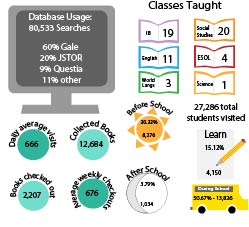The library released a compilation of data from the second quarter. The librarians collect data from the computer sign-in at the library entrance and they use the data to improve the function and effectiveness of the library.
“The data does help us with budgeting and prioritizing how we spend our time and our money,” librarian Krissy Ronan said.
The librarians evaluate database usage percentages to determine the budget for those resources.
“[We use] database usage to decide year to year whether or not we want to renew a certain database,” librarian Elizabeth Toledo said. “There’s one database that never makes the top three, so next year we’re not going to renew that one and we’ll look for more sources that are more useful for students.”
The librarians also track the types of classes that come to the library.
“We can see what departments to go after,” Toledo said. “We try to be able to touch every department.”
Beyond academic support, the librarians look for trends in student attendance in order to allocate their resources effectively.
Toledo said a wide variety of people use the library. The librarians strive to serve all students.
“We’ve had 2,206 students come here at least once,” Toledo said. “We can see how much of the student body we see.”
“When people sign in, it’s not attendance,” Toledo said. “It’s […] a number so we can pull a report. […] We can say we need more resources here or we could use more people here to accommodate more students.”
Toledo said they ultimately collect data about the library to ensure they are best serving Marshall’s needs.
“What can we do to be better, what is it that appeals the most to people, when are we most popular,” Toledo said. “We use this data to tell the story of what we do.
2019-03-18

